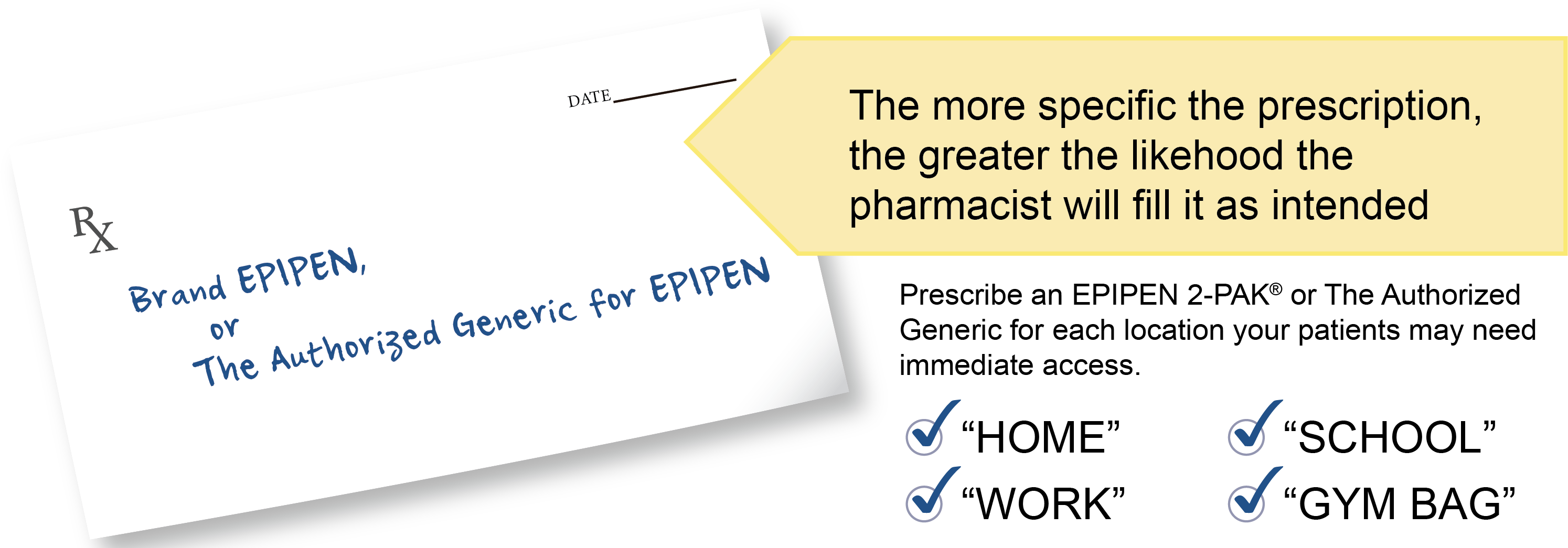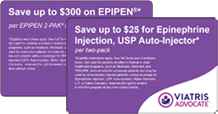
Dosage and Administration for EPIPEN® (epinephrine injection, USP) Auto-Injector and Its Authorized Generic
Selection of the appropriate dose of epinephrine is determined according to patient body weight and is described in Table 1. Each EPIPEN or EPIPEN JR® (epinephrine injection, USP) Auto-Injector (or their authorized generics) contains a single dose of epinephrine. Since the doses of epinephrine delivered from EPIPEN and EPIPEN JR Auto-Injector (or their authorized generics) are fixed, consider using other forms of injectable epinephrine if doses lower than 0.15 mg are deemed necessary. The prescriber should carefully assess each patient to determine the most appropriate dose of epinephrine.1,2
Table 1. Dosing for EPIPEN Auto-Injector and its authorized generic1,2
| Auto-Injector | Epinephrine Concentration | Patient Weight |
|---|---|---|
|
EPIPEN Auto-Injector
Epinephrine, USP Auto-Injector 0.3 mg |
0.3 mg (0.3 mL) | ≥30 kg (≥66 pounds) |
|
EPIPEN JR Auto-Injector
Epinephrine, USP Auto-Injector 0.15 mg |
0.15 mg (0.3 mL) | 15-30 kg (33-66 pounds) |
Prescribing EPIPEN Auto-Injector or its authorized generic
Nearly half of all anaphylactic reactions occur away from home, so consider the multiple settings where a patient may encounter a life-threatening allergen.3

How to use EPIPEN Auto-Injector and its authorized generic
It is important to counsel a patient on the correct administration technique for EPIPEN Auto-Injector and its authorized generic.1,2,4,5 (View a step-by-step video and share it with your patients.) It is also important to counsel the patient that not all epinephrine auto-injectors look and function the same way.
To download the Patient Information for EPIPEN and EPIPEN JR Auto-Injectors, including complete directions for use, please click here.
To download the Patient Information for the authorized generic to EPIPEN, including complete directions for use, please click here.
When should epinephrine be administered?
The immediate administration of epinephrine is critical for all patients meeting any of the three criteria outlined in the “Anaphylaxis Diagnosis Criteria” section.6,7 Any delay in treatment increases the risk of a life-threatening anaphylactic reaction or a biphasic reaction in these patients.7,8 Some patients not meeting these criteria may still need an immediate injection.6 For example, patients who have had a previous life-threatening anaphylactic reaction and who are exhibiting beginning signs of an allergic reaction after exposure to a known allergen should receive emergency treatment.6 There are no absolute contraindications to epinephrine administration for an anaphylactic reaction.1,2,5 It is important to administer epinephrine immediately.7-9
When a second dose of epinephrine may be warranted
In cases of suboptimal response to the initial dose of epinephrine, or if symptoms progress, the NIAID Expert Panel recommends repeat epinephrine dosing as first-line therapy over adjunctive treatments.4
NIAID food allergy guidelines recommend at-risk patients have access to two epinephrine auto-injectors.4 More than two sequential doses of epinephrine should only be administered under medical supervision.1,2
According to the NIAID food allergy guidelines, there are two reasons that patients should carry two doses of their epinephrine auto-injector.4,8
1. 20% of patients may need a second dose due to ongoing symptoms4,7
6.3.1.1 Epinephrine—first-line treatment
“If a patient responds poorly to the initial dose or has ongoing or progressive symptoms despite initial dosing, repeated dosing may be required after 5 to 15 minutes. Reports of patients receiving epinephrine for food-induced or non-food-induced anaphylaxis note that as high as 10%-20% of individuals who receive epinephrine will require more than 1 dose before recovery of symptoms.” 4
2. 20% of patients may experience a biphasic reaction4
6.2.3 Time course of food-induced anaphylaxis
“A biphasic reaction includes a recurrence of symptoms that develops after apparent resolution of the initial reaction. Biphasic reactions have been reported to occur in 1%-20% of anaphylaxis episodes and typically occur about 8 hours after the first reaction, although recurrences have been reported up to 72 hours later.” 4
Special Offers
Viatris offers Access and Savings Programs for eligible patients. See Terms and Conditions.
There’s only one recommended first-line treatment for anaphylaxis.
heading
Important Safety Information (the following information applies to both EPIPEN and its Authorized Generic)
EPIPEN (epinephrine injection, USP) 0.3 mg and EPIPEN JR (epinephrine injection, USP) 0.15 mg Auto-Injectors are intended for immediate administration as emergency supportive therapy only and are not intended as a substitute for immediate medical or hospital care. In conjunction with the administration of epinephrine, the patient should seek immediate medical or hospital care. More than two sequential doses of epinephrine should only be administered under direct medical supervision.
Rare cases of serious skin and soft tissue infections have been reported following epinephrine injection.
References
- EPIPEN (epinephrine) injection. Prescribing & Patient Information. 2023. Mylan Specialty L.P. Morgantown WV.
- EPINEPHRINE (epinephrine) injection. Prescribing & Patient Information. 2023. Mylan Specialty L.P. Morgantown.
- Wood RA, Camargo CA Jr, Lieberman P, et al. Anaphylaxis in America: the prevalence and characteristics of anaphylaxis in the United States. J Allergy Clin Immunol. 2014;133(2):461-467.
- Boyce JA, Assa’ad A, Burks AW, et al. Guidelines for the diagnosis and management of food allergy in the United States: report of the NIAID-sponsored expert panel. J Allergy Clin Immunol. 2010;126(6 suppl):S1-S58.
- Simons FE. Anaphylaxis: recent advances in assessment and treatment. J Allergy Clin Immunol. 2009;124(4):625-636.
- Sampson HA, Muñoz-Furlong A, Campbell RL, et al. Second symposium on the definition and management of anaphylaxis: summary report—second National Institute of Allergy and Infectious Disease/Food Allergy and Anaphylaxis Network symposium. J Allergy Clin Immunol. 2006;117(2):391-397.
- Simons FE. Anaphylaxis. J Allergy Clin Immunol. 2010;125(2)(suppl 2):S161-S181.
- Simons FE, Ardusso LR, Bilὸ MB, et al; World Allergy Organization. World Allergy Organization guidelines for the assessment and management of anaphylaxis. World Allergy Organ J. 2011;4(2):13-37.
- Lieberman P, Nicklas RA, Randolph C, et al. Anaphylaxis—a practice parameter update 2015. Ann Allergy Asthma Immunol. 2015;115(5):341-384.

This site is intended for US healthcare professionals.
If you are a patient, please check out our site for patients.

Prescribing Information
Please select from the following:

Patient Information
Please select from the following:



